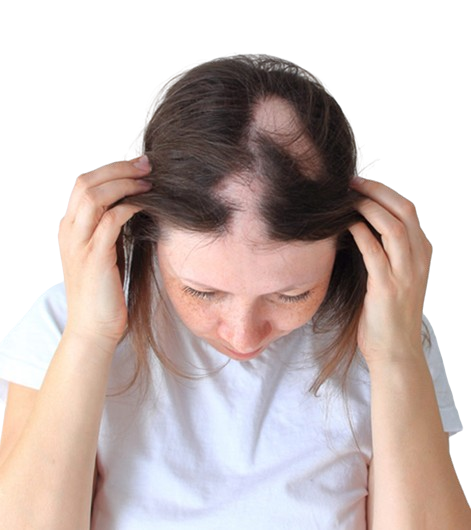Alopecia Areata IN PERUMBAKAM
Your Trusted Partner in Alopecia Areata
Alopecia Areata is an autoimmune condition that causes hair loss on the scalp and other parts of the body. We are here to offer you expert care and personalized treatment plans to address your condition and support your journey to recovery.

Understanding Alopecia Areata
What is Alopecia Areata?
Alopecia Areata is an autoimmune disorder characterized by sudden, patchy hair loss on the scalp and other areas of the body. In this condition, the immune system mistakenly attacks hair follicles, leading to hair loss. The extent and rate of hair loss can vary from person to person, and while some individuals may experience regrowth, others may have persistent or recurrent episodes of hair loss. Alopecia Areata can affect people of all ages, genders, and ethnic backgrounds.
What are the types of Alopecia Areata?
Alopecia Areata has several types based on the pattern and extent of hair loss:
Alopecia Areata (Patchy): The most common form, characterized by one or more round patches of hair loss on the scalp or other areas of the body.
Alopecia Totalis: A more severe form involving the complete loss of hair on the scalp.
Alopecia Universalis: The most advanced form, resulting in the complete loss of hair on the entire body, including the scalp, eyebrows, eyelashes, and other areas.
Diffuse Alopecia Areata: A less common form that causes sudden and widespread thinning of hair across the scalp rather than distinct patches.
Ophiasis: A rare form where hair loss occurs in a band-like pattern around the sides and back of the head.
What are the symptoms of Alopecia Areata?
- Patchy Hair Loss
Small, round, smooth patches of hair loss on the scalp or other body areas. - Sudden Onset
Rapid hair loss over a short period. - Itching or Burning
Possible itching or burning sensation in the affected area before hair loss begins. - Exclamation Mark Hairs
Short hairs that taper at the base, found at the edges of bald patches. - Nail Changes
Tiny dents, white spots, or roughness on fingernails and toenails.
What causes Alopecia Areata?
Alopecia areata is caused by an autoimmune reaction in which the body’s immune system mistakenly attacks healthy hair follicles, leading to hair loss. The exact triggers for this autoimmune response are not fully understood, but several factors may contribute, including:
- Genetics
A family history of alopecia areata or other autoimmune disorders can increase the likelihood of developing the condition. - Environmental Factors
Stress, infections, or other environmental factors may trigger the onset of alopecia areata in genetically predisposed individuals. - Immune System Dysregulation
An imbalance or malfunction in the immune system can lead to the immune system attacking hair follicles. - Hormonal Changes
Hormonal fluctuations, particularly those related to thyroid function, can be associated with alopecia areata. - Other Autoimmune Conditions
Having other autoimmune diseases, such as thyroid disease, vitiligo, or rheumatoid arthritis, can increase the risk of developing alopecia areata.
How is it diagnosed?
- Medical History: Review of personal and family medical history, focusing on hair loss and autoimmune disorders.
- Physical Examination: Detailed examination of hair loss patterns and scalp condition.
- Hair Pull Test: Gentle pulling of a small section of hair to assess hair loss extent.
- Dermatoscopy: Magnified examination of the scalp using a dermatoscope to identify characteristic features.
- Scalp Biopsy: Collection and microscopic examination of a small scalp tissue sample.
- Blood Tests: Tests to check for other autoimmune conditions or thyroid issues.
How do you treat Alopecia Areata?
Treatments for alopecia areata aim to promote hair regrowth and manage symptoms. Available treatments include:
- Topical Corticosteroids: Applied directly to the bald patches to reduce inflammation and encourage hair growth.
- Intralesional Corticosteroids: Injected into the bald areas to promote hair regrowth.
- Topical Immunotherapy: Chemicals like diphencyprone (DPCP) are applied to the scalp to create an allergic reaction that stimulates hair growth.
- Minoxidil (Rogaine): A topical treatment that can promote hair regrowth.
- Oral Medications: Corticosteroids or other immunosuppressants taken orally to reduce immune system activity.
- Anthralin: A topical cream used to control inflammation and stimulate hair regrowth.
- JAK Inhibitors: Oral medications like tofacitinib and ruxolitinib that target immune pathways involved in alopecia areata.
- Laser Therapy: Low-level laser therapy (LLLT) can stimulate hair growth.
- Platelet-Rich Plasma (PRP): Injections of the patient’s own platelet-rich plasma to stimulate hair follicles.
- Wigs and Hairpieces: Non-medical options to cover hair loss areas.
